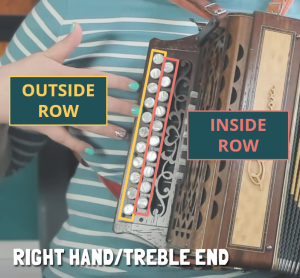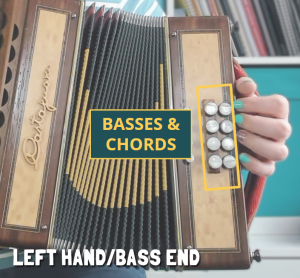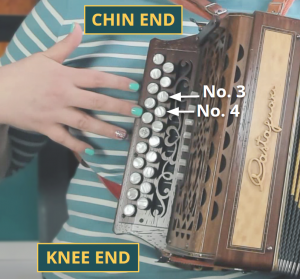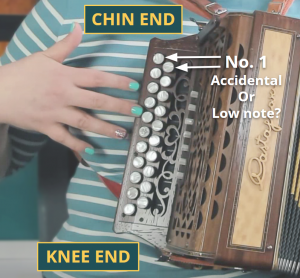
It’s a common issue to not know what type of melodeon you have, or whether it’s appropriate for the type of music you want to learn.
I get many enquiries from people wanting tuition who have either bought or inherited a squeezebox and don’t know what type of melodeon they’ve got.
It’s completely understandable though. Even though diatonic button accordions (the official name for melodeons/button accordions) come in a variety of different sizes, layouts and keys; to look at from the outside they all look pretty similar!
That’s where I can help!
In this post I will help you to establish how many rows and basses your melodeon has, what key(s) it’s in and how they relate to different world music genres, and what ‘button start’ it is.
Armed with this information, you’ll be able to take the first step on your Melodeon Journey with confidence. So let’s get investigating!
Jump to:
Know how many rows and basses your melodeon has
Know how melodeon rows and keys are related
Know what layout your melodeon is
Know what button start your melodeon is
Know if your melodeon has accidentals or low notes
Getting your box converted to 4th button start
Know how many rows and basses your melodeon has
The easiest thing to do first is count how many rows and basses your box has.
The outside row is located furthest from the bellows, and the inside row is located nearest the bellows. You might also have a middle row in between.
Look at the right hand or treble end. Can you count 1-row, 2-rows, 2.5-rows or 3-rows of buttons?
If it’s 2 rows, do you have 19, 21 or 23 buttons?

Now look at the left hand or bass end. How many buttons can you count?
Commonly, you get 2 or 4 basses on 1-row instruments, 8 or 12 basses on 2-row and 2.5-row instruments, and 12 or 18 basses on 3-row instruments (but there are exceptions to these standards!).
The bass end buttons are made up of single note ‘basses’ (the big, deep, farty sounding ones) and multi note chords (the lighter, more tinkly sounding ones).

Know how melodeon rows and keys are related
Each row of buttons represents a different ‘key’ or ‘scale’ of notes. For instance, my DG box has the notes of the D major scale on the outside row, and the notes of the G major scale on the inside row.
You read the rows outside to inside, hence ‘DG’ melodeon.
Diatonic accordions are commonly tuned in keys separated by an interval of a 4th. You may have heard the term “4th apart box” e.g. G is an interval of a 4th higher in pitch than D.
What do ‘key’, ‘scale’ and ‘interval’ mean?
A ‘key’ is the main group of pitches, or notes, that form the harmonic foundation of a piece of music. There is always a major and minor key for each ‘key signature’.
A ‘scale’ is a group of notes that are organised in ascending or descending pitch. Relative major and minor keys share the same scale.
An ‘interval’ is the distance in pitch between two notes and is labelled by it’s numerical value.
Other commonly found 4th apart boxes include: C/F, G/C, Bb/Eb, A/D, and B/E.
These types of tunings are typically found in English, Continental European, Scandinavian, Columbian and South American playing styles.
You may have a ‘chromatic’ or ‘semitone’ box, also known as an ‘Irish’ or ‘Celtic’ system. These are usually tuned a semitone apart e.g. D/D#, C/C#, B/C, C#D etc.
What about 2.5-row and 3-row models?
Generally, more rows = more keys e.g. A/D/G, G/C/F, B/C/C# etc.
However, some 3-row models have an inside row of ‘accidentals’ and ‘reversals’ e.g. G/C/Acc or D/G/Acc etc.
2.5-row models have 2 main rows and a half row of accidentals and reversals.
2.5 and 3-row melodeons are more likely to have “custom” layouts that may be specific to an individual or genre.
What are ‘accidentals’ and ‘reversals’?
‘Accidentals’ are extra notes that lie outside of the key signature. They may be located in a row all to themselves (an inner row of 2, 4 or 5 buttons or a full 3rd row) or at button number 1 at the chin end of each row.
‘Reversals’ are notes which appear duplicated in the layout but in the opposite or ‘reversed’ direction to that of their main row counterpart. For example, a note which appears as PUSH on the main rows can have a PULL reversal on the extra half or full 3rd row, and vice versa.
Know what layout your melodeon is
There are numerous different diatonic accordion keyboard layouts out there. You may have heard of some of the popular ones such as: Anahata or G scale, Bob Ellis, Andy Cutting, Heim, Laloy-LeTron or Milleret-Pignol.
Their purpose is to establish where notes, basses and chords are positioned across the instrument.
They also establish which button the right hand/treble scales start on. The most common layouts are 3rd or 4th button starts. But in my time as a melodeon teacher I have known 2nd and even 5th button start custom boxes!
Layout charts are freely available on melodeon.net for many different types of instrument
Know what button start your melodeon is
Usually, the quickest and easiest way to find out what button start the box has is to ask the person you bought it from.
But if this isn’t an option, follow these simple instructions to work it out:
- Buy a digital tuner or download a free tuning app on your phone/iPad – switch it on/open it. There are loads on Google Play/Apple IOS store – find a simple one that works for you
- Find the inside row on your right hand/treble end
- Starting at the chin end of the keyboard, count to button 3 (see pic)
- Open the bellows, press button 3 and push the bellows to sound the note
- Check your tuner to see what note it’s telling you

For example, if your tuner tells you the note is a G, then you have a 3rd button start D/G instrument. To be doubly sure, check if button 3 on the outside row is a D.
Use this table to work out other tunings:
| Inside row note | Outside row note | Melodeon tuning |
|---|---|---|
| C | G | G/C |
| C | B | B/C |
| F | C | C/F |
| D | A | A/D |
| Eb(D#) | Bb(A#) | Bb/Eb |
| C#(Db) | C | C/C# |
| D#(Eb) | D | D/D# |
Things to remember
- If you’re not getting any of these results from button 3, repeat the process for button 4 instead.
- Sharps (#) have equivalent flats (b) and vice versa (shown in brackets in case your tuner uses either/or).
- If you have a 3-row – remember your inside row might be made up of accidentals and reversals. So try this exercise again with the outside and middle rows.
- Alternatively your 3-row might have 3 full scales e.g. G/C/F. This will mean that button 3 (or 4) on the inside row should be F, middle row will be C and outside row will be G.
Once you know what type of melodeon you have, what button your scale starts on, and what keys your instrument is tuned in, you can try playing a push-pull scale up and down each row.
Know if your melodeon has accidentals or low notes
Some melodeon layouts come with accidentals OR low notes on button 1 of each row. Know if your melodeon has accidentals or low notes by how the notes sound or you can use your tuner for accuracy.
Accidentals are extra notes that lie outside of the keys of your melodeon. They usually sound squeakier or sound out of place. But if you have them they are incredibly useful as they open up the opportunity to play in keys outside of the main range.
Low notes will sound low and farty, and are a continuation of the main scales into the lower octave.
For DG players especially, it is useful to have low notes AND accidentals. You can achieve this with a 4th button start layout.
You may need to have your instrument converted in order to achieve this.

Getting your box converted to 4th button start
3rd to 4th button start conversions are a common upgrade and involve shunting the reeds on the reed block down a hole in order to create space for the new low reeds to be waxed in.
This process sacrifices the topmost notes at the knee end of the keyboard, so don’t rush into this decision if you play a smaller or short scale instrument e.g. 19 button layout. You may end up limiting yourself in the top octave region of the keyboard.
It’s not too expensive to have this work done and after a short re-familiarisation period you’ll have so many more options available. Speak to your fettler about the possibility of having your instrument converted.
Now you know what type of melodeon you have…
Now you know what type of melodeon you have, you can start your first steps along your Melodeon Journey with me!
Click on the tiles below to read more about my online teaching products:
You can read more about what teaching I offer here.



